Monetary Policy Transmission – What's Known and What's Changed
Christopher Kent
Assistant Governor (Economic)
Public Lecture at the Australian National University
Canberra - 15 June 2015
1. Introduction
I'd like to thank Rohan Pitchford and Martin Richardson for organising this event. It's great to be back at the ANU, where almost 30 years ago I was embarking on my study of botany just across campus, with some economics on the side for good measure. It was my dislike of compulsory chemistry classes led me down that side path.
Tonight I want to talk about the effects of monetary policy on the economy. Interest rates have been at very low levels for some time. Yet economic growth is below trend, the unemployment rate is relatively high and domestic inflationary pressures are well contained. This is expected to remain the case for a time. It's natural then to ask whether monetary policy is less effective than in the past.
Almost 20 years ago, Stephen Grenville, who was in my current role at the time, gave a comprehensive account of what we knew and didn't know about the transmission of monetary policy in Australia.[1] The structure of the economy has changed since then in ways that may have altered the transmission mechanism.
So it is timely on two counts to consider how the monetary policy transmission mechanism is operating in the current environment.
2. How Monetary Policy Works (in Theory)
2.1 Overview of the transmission mechanism
In responding to cyclical developments and inflation pressures, monetary policy has a significant influence on aggregate demand and inflation. The transmission of interest rates through the economy can be roughly described as follows. I'll focus on an easing of monetary policy.
- The Reserve Bank lowers the overnight cash rate.
- Financial markets update expectations about the future path of cash rates and the structure of deposit and lending rates are quickly altered.
- Over time, households and firms respond to lower interest rates by increasing their demand for credit, reducing their saving and increasing their (current) demand for goods, services and assets (such as housing and equities).
- Other things equal, rising demand increases the prices of non-tradable goods and services. The price-setting behaviour of firms depends on demand conditions and the cost of inputs, including of labour. Higher aggregate demand leads to increased labour demand and a rise in wages.
The transmission mechanism depends crucially on how monetary policy affects households' and firms' expectations. Expectations about the future path of the cash rate will affect financial market prices and returns, asset prices and the expected prices of goods, services and factors of production (including labour). Expectations of more persistent changes in the cash rate will have larger effects.
The extent to which lower interest rates lead to extra demand will depend on how households and businesses alter their behaviour regarding borrowing and investing, as well as consuming and saving. These responses are often described as occurring via a number of different channels.
2.2 How interest rates affect demand – various channels
The exchange rate channel is one way in which interest rates affect demand. Lower interest rates contribute to an exchange rate depreciation by reducing returns to, and hence the demand for, domestic assets relative to foreign currency‑denominated assets. A depreciation increases the prices of foreign products relative to domestic products. This leads to a switching of demand towards domestically produced goods and services. (A lower exchange rate also leads directly to an increase in import prices.)
Many macroeconomic models emphasise intertemporal substitution as the primary transmission channel. Households and businesses make decisions about whether to save more or less now so as to spend more or less later. Lower interest rates provide less reward for saving, thereby encouraging more expenditure in the near term (and less further out).
Decreases in interest rates will boost asset prices, which can have a number of effects. First, it boosts investment in housing, equipment and other capital goods as it becomes less expensive to build than to buy (this is likely to be important, although empirical evidence of the relevance of the ‘q-ratio’ is weak). Second, households typically respond to an increase in their net worth by consuming a little more at each point in time. This is known as thewealth channel, which appears important in the Australian context. The balance sheet channel is closely related. Rising net worth makes it easier to borrow, with higher collateral values making lending a less risky proposition.
The cash-flow channel appears to be an important part of the transmission mechanism in Australia. Changes in interest rates affect households' and businesses' cash flows. If they face liquidity or borrowing constraints, an increase in cash flows will typically lead to more spending.[2] For example, a decrease in interest rates lowers interest payments for households with variable-rate mortgages, leaving them with more disposable income to spend. At the same time, cash flows will be lower than otherwise for those with interest-earning assets and they may choose to restrict their spending. Notwithstanding this latter effect, decreases in interest rates can be expected to increase demand through this channel. This reflects the fact that the household sector in Australia is a net borrower, by which I means that its interest bearing liabilities are greater than its interest-earning assets.[3] Moreover, it seems plausible that marginal propensities to spend are generally higher for debtors (who may face credit constraints) than for creditors.
That's a rough sketch of the theory of the transmission mechanism. What can we say about it in practice and how might it have changed over time?
3. Estimates of the Overall Effect of Monetary Policy
It is difficult enough to estimate the strength of the monetary policy transmission mechanism in terms of its effect on the economy overall. It is harder still to separately identify the strength of each of the various channels. A key challenge is disentangling the effect of monetary policy from other influences, such as foreign developments or changes in fiscal policy. This requires models that simultaneously account for these and other forces.
There are a wide range of model estimates from which to choose, each capturing different aspects of the ways in which the world works in reality. For illustrative purposes, let me mention just one set of recent estimates provided by some of my colleagues using a so-called Dynamic Stochastic General Equilibrium (DSGE) model.[4] Consider the estimated effects of a decrease in the cash rate of 100 basis points. This will lead GDP to be higher than otherwise by between about ½ and ¾ of a percentage point over the course of two years (Graph 1). Inflation is estimated to rise by somewhat less than ¼ percentage point per annum over 2–3 years. These estimates are close to those of other models. [5]
Graph 1
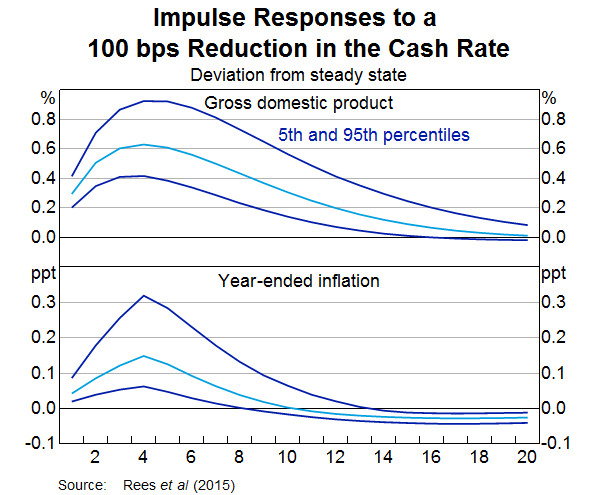
Click to view larger
Estimates from this DSGE model tentatively suggest that the overall effect of monetary policy has not changed significantly in recent years. In particular, estimates of the ‘endogenous’ relationships in the model based on data up to 2008 (after which interest rates have been notably lower) are about the same as estimates based on data to the present day. This suggests that the period of below-trend growth in GDP over the past few years may not reflect a change in the monetary policy transmission mechanism. Rather, the model attributes below-trend growth to sizeable exogenous forces or shocks. The sharp fall in commodity prices has played an important role of late. Also, weakness in private investment – beyond that which can be explained by subdued domestic demand and falling commodity prices – has made a sizeable contribution to below-trend growth. The model also suggests that consumption growth has been a bit weaker than in the past.
These estimates provide some tentative evidence that the overall effect of monetary policy is neither more nor less effective than in the past. However, it may be that it's too early to identify any structural change with the data to hand. Alternatively, the effect of monetary policy on overall activity and inflation might be close to its historical average, but this could mask changes in its effects across different parts of the economy or variation in the relative strength of the different channels from one episode to the next.
4. Estimates of Some Channels of Monetary Policy
I'll consider this possibility by looking more closely at the behaviour of dwelling construction and household consumption. I'll leave to one side the effects of monetary policy on business investment and external trade.[6] I'd note though that a further rise in the growth rate of household expenditure should contribute, in time, to a pick-up in non-mining business investment. So too would a further depreciation of the exchange rate, which would raise the demand for domestic production. We have argued that a further exchange rate depreciation appears likely and necessary, particularly given the large declines in commodity prices this year.
4.1 Responsiveness of dwelling construction
Dwelling construction is typically the most interest-rate sensitive component of expenditure in the Australian economy. It is growing strongly in response to low interest rates, rising by about 9 per cent over the past year (Graph 2).
The results of a standard ‘single-equation’ reduced-form model suggest that the response (to date) of residential building approvals to lower interest rates and higher housing prices is broadly consistent with historical experience.[7]
Although the behaviour of construction investment over the past few years is not unusual, it is possible that with a period of very low rates there will be some limit as to how much demand for dwelling construction can be brought forward from the future.
It is also possible that a period of very low interest rates will eventually lead to higher inflation for land and construction work, as is normally required to bring forth more supply of a particular good or service. These pressures might arise from a depletion of suitable land available for development or a need to attract more developers and workers into the industry. In such circumstances, any further increases in construction demand would tend to push up prices of existing and new dwellings. This could occur via increases in land prices, construction wages, developers' margins or some combination of all three. The direct effect of additional demand for construction on economic activity would be less than in the case of ample spare capacity. But such a situation would still provide support to aggregate demand in other ways, including via the operation of the balance-sheet and wealth channels.
Graph 2
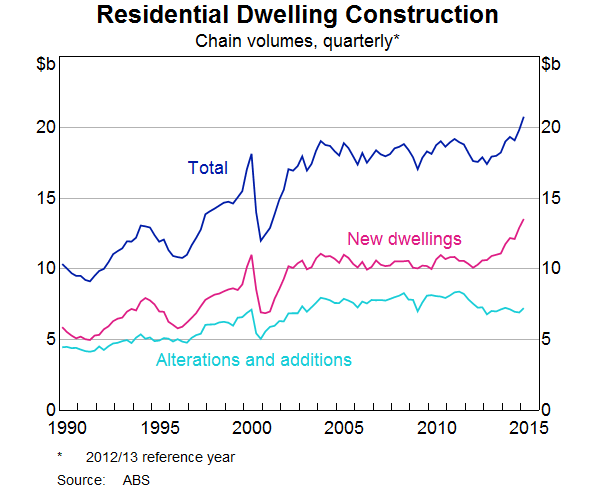
Click to view larger
There is evidence of some tightening in supply in pockets of the country. In some cities, stocks of unsold lots suitable for development appear to be unusually low (Graph 3). Shortages are most evident in Sydney, where greenfield land releases have not kept pace with recent strong demand. Also, some of the Bank's liaison contacts are concerned that the stock of suitable sites for apartment developments in Sydney has been depleted in the past few years.
There is little evidence of labour supply constraints outside a few trades and professional roles. However, inflation of building material prices has risen and the Bank's liaison suggests that some builders have increased margins over the past year or so. Consistent with this, inflation in new dwelling costs has risen to be almost 2 percentage points above its average over the inflation-targeting period; although, it is still below that seen when dwelling construction was strong in the early 2000s.
Graph 3
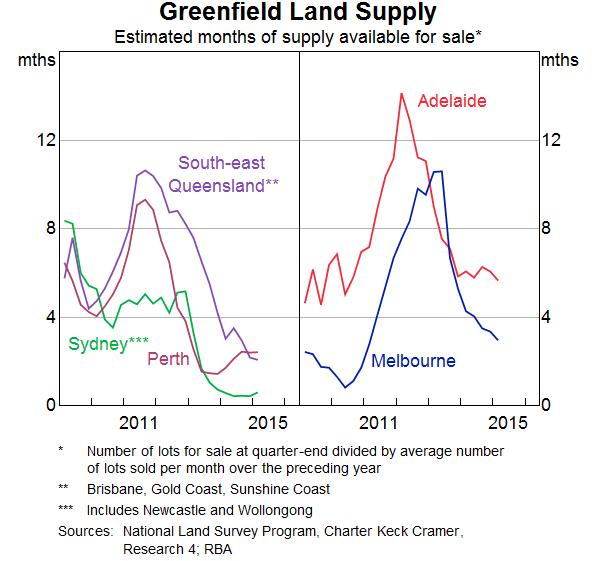
Click to view larger
Despite the potential emergence of some constraints affecting the supply of new dwellings in pockets of the country, there appears to be scope for strong growth in new dwelling construction in other parts of the country. Moreover, alterations and additions activity could pick up. This used to account for about 45 per cent of total dwelling construction, but has declined over the past few years, despite lower interest rates and the sizeable increase in dwelling prices.
In short, there are some signs of tightening supply conditions in pockets of the country, but dwelling construction overall is responding to low interest rates much as it always has done.
4.2 Consumption and the behaviour of borrowers and savers
What about the effect of low interest rates on household consumption?
This can be modelled in a simple way by linking household consumption to disposable income and household wealth. In such a model, lower interest rates affect consumption indirectly by increasing household disposable income and boosting both housing and equity prices.[8]
This simple model (like the DSGE model results I discussed) provides some tentative evidence that consumption growth has been a bit weaker over recent years than suggested by historical experience. Much of that history, however, captures the period of adjustment to easier access to credit from the early 1990s to the mid 2000s. At that time, household indebtedness increased substantially and the saving ratio declined to be well below earlier norms (Graph 4).[9] So in a way, the more recent experience could be regarded as the more standard response. Indeed, the behaviour of late appears more sustainable than that of the previous episode. [10]
Graph 4

Click to view larger
One aspect of this change in behaviour is evident in households injecting equity into the housing stock over recent years. That is, their net new spending on housing assets has exceeded their borrowing secured over housing. This stands in stark contrast to the period of strong housing market conditions in the first half of the 2000s, which saw households withdrawing housing equity to help finance their consumption (Graph 5). [11]
Graph 5
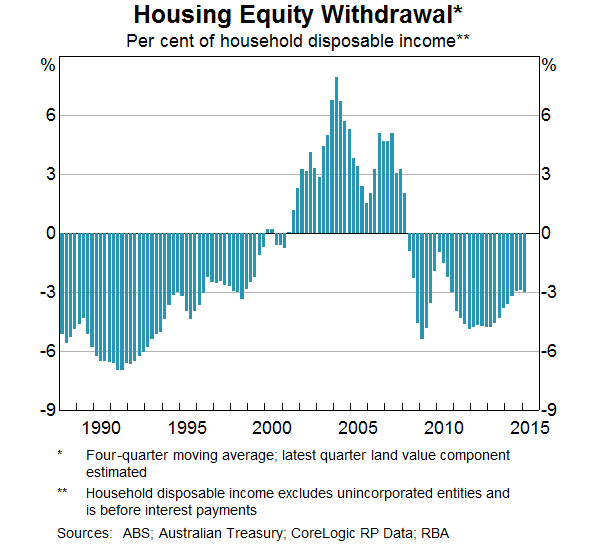
Click to view larger
As I just mentioned, the experience of recent years is characterised by slightly lower growth of consumption than might have been expected. However, the responsiveness of consumption to disposable incomes and wealth does not appear to have changed, at least in a statistically significant way.
There are two possible explanations for this observation. First, the growth of consumption of late could be affected by factors other than the stance of monetary policy. Second, it may be that the strength of the various monetary policy transmissions channels affecting consumption has changed, but in ways that are difficult to identify using models of aggregate household behaviour. Although it is hard to be definitive, my sense is that both these explanations are likely to be true.
Let me start with changes affecting the cash-flow channel. Net interest payments of households are now more responsive to changes in interest rates than they were a decade or more ago (at least in the short term). To illustrate the magnitude of this, we can estimate the effects of a 100 basis point reduction in the cash rate on net interest payments (as a share of household disposable incomes; Graph 6). [12]
Graph 6
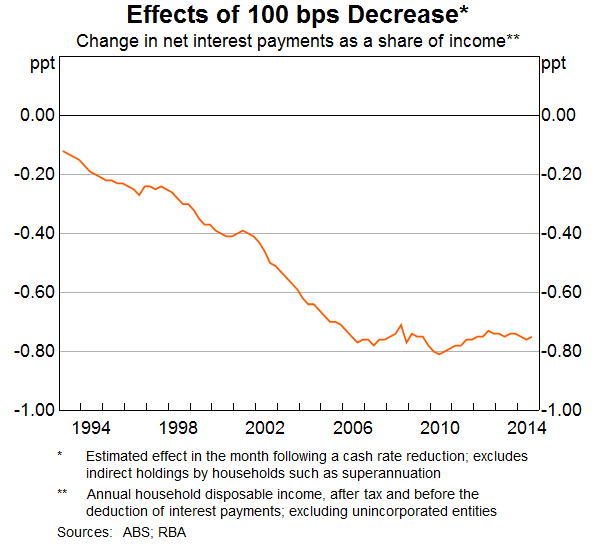
Click to view larger
There has been a noticeable increase in households' holdings of interest-earning assets (such as bank deposits) over recent years (Graph 7). But despite this, a reduction in interest rates still lowers households' net interest payments, and by much more than was the case in earlier decades. This larger response reflects the substantial increase in housing credit from the early 1990s to the mid 2000s.
Graph 7
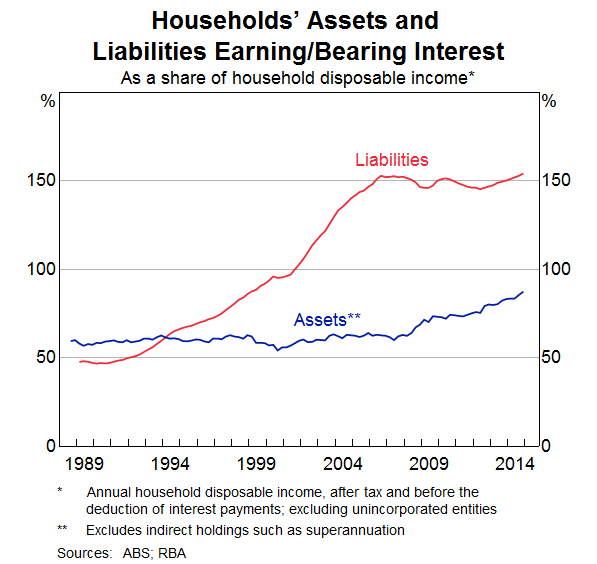
Click to view larger
By itself, the greater responsiveness of net interest payments implies that the cash‑flow channel should be stronger now than it was previously. Other things equal, we might have expected that the stronger effect of interest rates on the average household's cash flows, and the operation of the other channels of monetary policy, would have encouraged a more noticeable rise in debt and a larger increase in current consumption in response to very low interest rates. Yet household indebtedness has been relatively stable for some years now (Graph 7 and Graph 9). While low interest rates may have helped to support consumption and debt, other forces appear to have been working in the opposite direction. Moreover, the response of consumption and indebtedness will depend on how different types of households are responding to these forces. Let me make this clearer with some examples.
Some households may have revised down their expectations for income growth and may also be more uncertain about their incomes. This would be consistent with the substantial decline in wage growth and the rise in the unemployment rate over the past few years.[13] This could have caused some households to have become uncomfortable with the levels of debt that they had been carrying. Accordingly, many households may have decided to pay down their debts faster than they would have in a world of unchanged expectations about incomes, thereby contributing to a period of weaker consumption growth. In such an environment, lower interest rates help to facilitate ‘deleveraging’, hastening the time at which those households will feel more secure about their financial situation.
There is evidence of many households behaving in this way. In particular, the rate of mortgage prepayments has increased as interest rates have fallen and more households are well ahead of their required schedule of repayments (Graph 8). [14][15]
Graph 8
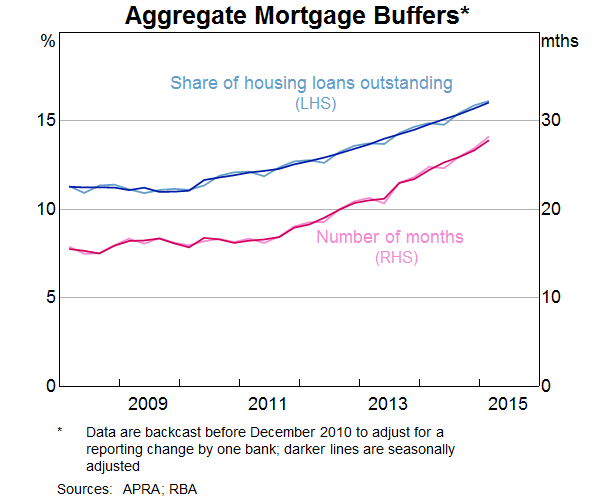
Click to view larger
Also, if we deduct funds held in mortgage offset accounts and ignore investor credit, we can see that the rest of household credit has declined by about 4 percentage points as a share of household disposable income since early 2010. This is consistent with a degree of deleveraging among some households, particularly when we consider that low interest rates might otherwise have encouraged a general increase in this type of credit over that period (Graph 9). [16]
Graph 9

Click to view larger
What about those households that rely on interest-bearing assets? Their disposable incomes are lower than otherwise given the sizeable decline in interest rates.[17] Accordingly, such households may be reluctant to maintain consumption by either running down their pool of liquid assets, or accessing capital gains they may have enjoyed on any housing or equities that they hold. Such behaviour would contribute to the growth of aggregate consumption being less responsive to a decline in interest rates than in the past.
Finally, let's consider those households with some spare funds to invest. The very low level of interest rates may have prompted such households to search for yield. Many of these households have combined those spare funds with new debt to purchase housing for the purposes of investment. Indeed, the strong growth of investor housing loans has driven the growth in household debt (as a share of disposable incomes) over recent years and contributed to a rise in both housing prices and dwelling construction. While this may not directly contribute to a rise in consumption of households undertaking the investment, it will support overall economic activity nonetheless.
Conclusions
Monetary policy is clearly working to support demand, although it is working against some strong headwinds. These include the significant decline in mining investment, fiscal consolidation at state and federal levels and the exchange rate, which continues to offer less assistance than would normally be expected in achieving balanced growth in the economy. Model estimates that control for these and other forces provide tentative evidence that the monetary policy transmission mechanism, in aggregate, is about as effective as usual. However, it may be too early to pick up a statistically significant change using such models.
As usual, dwelling construction is growing strongly in response to low interest rates, and this is making some contribution to the growth of aggregate demand and employment. It may be that in parts of the country, any further substantial increases in residential construction activity might run up against some supply constraints, putting further upward pressure on housing prices. As the Bank has noted for some time now, large increases of housing prices, if accompanied by strong growth of credit and a relaxation of lending standards, are a potential risk for economic stability. Accordingly, the Bank is working with other regulators to assess and contain such risks that may arise from the housing market.
Consumption growth has picked up since 2013. But it is still a little weaker than suggested by historical experience. This may reflect a number of factors including some variation in the ways that the different channels of monetary policy are affecting households according to their stage in life. Some indebted households appear to be taking advantage of low interest rates to pay down their debts faster than has been the norm, perhaps in response to weaker prospects for income growth. Those relying on interest receipts may feel compelled to constrain their consumption in response to the relatively long period of very low interest rates. Meanwhile, the search for yield is no doubt playing a role in driving the strong growth of investor housing credit. This might provide some indirect support to aggregate demand, but this channel is not without risk.
In short, monetary policy is working. The transmission mechanism may have changed in some respects, and this could help to explain lower-than-expected growth of consumption and debt of late. But it is hard to be too definitive. To know more about this, it would be helpful to better understand the behaviours of different types of households using household-level data. To use a botanical analogy, to know more about a plant, it’s helpful to observe how its different types of cells work.








Add a Comment
We encourage you to use comments to engage with other users, share your perspective and ask questions of authors and each other. However, in order to maintain the high level of discourse we’ve all come to value and expect, please keep the following criteria in mind:
Enrich the conversation, don’t trash it.
Stay focused and on track. Only post material that’s relevant to the topic being discussed.
Be respectful. Even negative opinions can be framed positively and diplomatically. Avoid profanity, slander or personal attacks directed at an author or another user. Racism, sexism and other forms of discrimination will not be tolerated.
Perpetrators of spam or abuse will be deleted from the site and prohibited from future registration at Investing.com’s discretion.